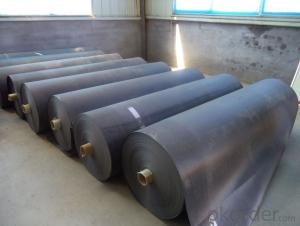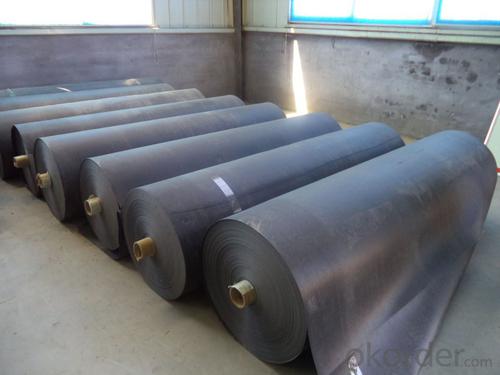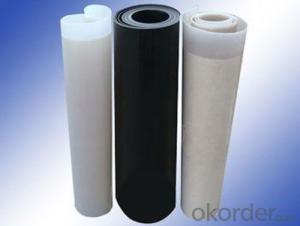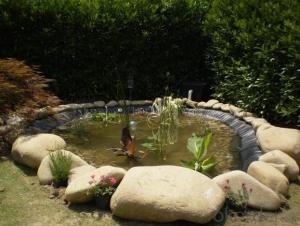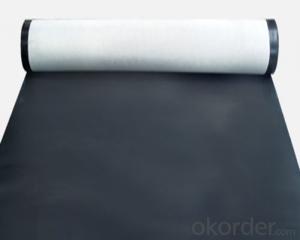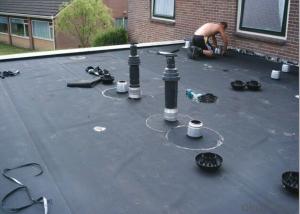EPDM rubber waterproof membrane for roofs
- Loading Port:
- Qingdao
- Payment Terms:
- TT OR LC
- Min Order Qty:
- 500 m²
- Supply Capability:
- 1000000 m²/month
OKorder Service Pledge
OKorder Financial Service
You Might Also Like
1. Introduction
| EPDM waterproof membrane is made from ternary ethylene-propylene
rubber, which is for waterproofing of exposed and non-exposed applications.
| EPDM waterproof membrane production adopts the world-advanced equipment of
cold feeding extrusion and continuous vulcanization technology.
| EPDM waterproof membrane is of high elasticity among high polymer waterproof materials and becomes a world-popular waterproofing material.
2. Specification
1) Material: EPDM Rubber
2) Size: 1.2m (width)*20m (length) or customized,
3) Thick: 1.2mm, 1.5mm, 2.0mm
4) Type: vulcanized
5) Pattern: Non-reinforced (homogeneous)
6) Heat resistance to 150 celsius degree
6) Certificate: ISO9001/14001
3. Features
| Excellent physical and mechanical performance
| High tearing resistance
| Good deformation adaptability
| High puncture resistance
| High aging resistance
- Q: Is a waterproofing membrane compatible with different types of adhesives?
- Certainly, various types of adhesives typically work well with a waterproofing membrane. Nevertheless, it is crucial to verify that the adhesive chosen is appropriate for the specific waterproofing membrane in use. The compatibility of different adhesives with various waterproofing membranes can vary due to differences in composition and surface properties. Seeking advice from the manufacturer or supplier of both the waterproofing membrane and adhesive is advised to ascertain their compatibility and suitability for the desired application. Moreover, adhering to the manufacturer's instructions and guidelines for both the membrane and adhesive will guarantee a proper installation and long-lasting effectiveness.
- Q: Can a waterproofing membrane be used on wood block surfaces?
- Certainly! Waterproofing membranes are a suitable option for safeguarding wood block surfaces. The utilization of a waterproofing membrane on wood block surfaces, like decks or wooden floors, can prove advantageous by shielding against water damage and prolonging the wood's lifespan. These membranes function as a barrier, effectively preventing water from infiltrating the wood and causing deterioration, such as rot, warping, or decay, over time. To guarantee optimal outcomes, it is crucial to select a waterproofing membrane explicitly designed for wood surfaces and adhere to the manufacturer's instructions for application. By doing so, the wood block surface can be adequately protected and maintained, ensuring its resilience and longevity.
- Q: Is a waterproofing membrane resistant to gasoline or other petroleum-based substances?
- Yes, a waterproofing membrane is typically resistant to gasoline and other petroleum-based substances. Most waterproofing membranes are made from materials such as polyurethane or PVC, which are known for their resistance to chemicals and petroleum products. This resistance ensures that the membrane remains intact and effective in preventing water infiltration even when exposed to gasoline or other petroleum-based substances. However, it is important to note that the specific resistance level may vary depending on the type and quality of the waterproofing membrane used. It is advisable to consult with a professional or check the product specifications to ensure that the chosen membrane is suitable for the intended application involving gasoline or petroleum-based substances.
- Q: Are waterproofing membranes resistant to oil and fuel spills?
- Yes, waterproofing membranes are generally resistant to oil and fuel spills. These membranes are specifically designed to create a barrier that prevents water or any other liquid from penetrating through them, including oil and fuel. They are often made from materials such as polyurethane or PVC, which have excellent resistance to various chemicals, including oil and fuel. This makes them suitable for applications where there is a possibility of oil or fuel spills, such as parking garages, industrial facilities, or areas where vehicles are present. However, it is essential to note that the level of resistance may vary depending on the specific type and quality of the membrane used. Therefore, it is crucial to choose a high-quality and appropriate waterproofing membrane that meets the specific requirements of the project to ensure long-term resistance to oil and fuel spills.
- Q: How does a waterproofing membrane handle water pressure from below?
- To prevent water from penetrating through, a waterproofing membrane is created to withstand water pressure from below. This membrane acts as a layer of protection, preventing water from seeping into the applied structure or area. Typically, the membrane is made from materials like rubber, PVC, or bitumen, which possess excellent water-resistant properties. These materials are flexible and can stretch to accommodate movement in the structure, ensuring the integrity of the membrane even in dynamic conditions. When faced with water pressure from below, the waterproofing membrane resists the force exerted by the water, effectively barring its entry into the structure. The membrane is installed to cover the entirety of the area requiring protection, creating a seamless and continuous barrier against water intrusion. Moreover, waterproofing membranes often possess additional features, such as reinforcement layers or fabric backings, to enhance their strength and durability. These features enable the membrane to withstand higher water pressures and reduce the risk of leaks or water damage. It is important to note that the effectiveness of a waterproofing membrane in handling water pressure from below depends on various factors, including the quality of the membrane, proper installation techniques, and the specific conditions of the site. Adequate surface preparation, correct membrane application, and regular maintenance are crucial to ensure the long-term performance of the waterproofing system. In summary, a waterproofing membrane is designed to create a robust barrier that can handle water pressure from below, safeguarding the structure or area from potential water damage.
- Q: Can a waterproofing membrane be used on precast plaster surfaces?
- Indeed, precast plaster surfaces have a tendency to be porous, enabling them to absorb water. This absorption can ultimately result in water damage and deterioration. Nevertheless, by utilizing a waterproofing membrane, this problem can be mitigated. The application of such a membrane serves to impede water penetration and safeguard the surface against moisture-related predicaments like mold, mildew, and efflorescence. Essentially, the waterproofing membrane functions as a protective barrier, effectively halting water from permeating the plaster and causing harm. It is crucial to ensure that the membrane employed is compatible with the specific type of plaster and is administered accurately in order to attain optimal waterproofing outcomes.
- Q: How does a waterproofing membrane handle water infiltration through cracks or gaps?
- By forming a seamless barrier, a waterproofing membrane effectively addresses the issue of water infiltration through cracks or gaps. Typically constructed from durable and flexible materials like rubber, PVC, or modified bitumen, the membrane possesses the ability to withstand the movement and expansion of the underlying structure. When encountering a crack or gap on the surface, the membrane acts as a seal, halting the water from progressing further. The material utilized in the membrane is impervious to water, signifying that it does not permit water molecules to permeate its surface. Furthermore, the membrane is installed in a manner that encompasses the entire surface area, including any existing cracks or gaps. This guarantees the absence of vulnerable points in the waterproofing system, preventing water infiltration. Additionally, the membrane is designed to possess flexibility. This adaptability enables it to accommodate any movement or shifting of the underlying structure without compromising its ability to repel water. This quality proves particularly crucial in areas where cracks or gaps may emerge as a result of natural settling or movement of the building. All in all, a waterproofing membrane capably manages water infiltration through cracks or gaps by providing an uninterrupted, impenetrable barrier that obstructs water from penetrating the structure. It represents a dependable solution for safeguarding buildings and structures from water damage and preserving their integrity over time.
- Q: Can a waterproofing membrane be used for below-grade applications?
- Below-grade applications can benefit from the utilization of a waterproofing membrane. Construction projects commonly employ this technique to safeguard basements, foundations, and retaining walls against water infiltration. The purpose of a waterproofing membrane is to create a barrier against water and moisture, thereby shielding the structure from potential harm. Generally, this membrane is applied to the exterior side of the below-grade structure, acting as a protective layer that hinders water from seeping into the building. The formulation of waterproofing membranes for below-grade applications is specifically tailored to withstand the considerable hydrostatic pressure exerted by surrounding soil and water. They are typically constructed from durable materials like modified bitumen, rubberized asphalt, or polyvinyl chloride (PVC), capable of enduring the challenging conditions commonly encountered below grade. Moreover, these membranes are designed to exhibit flexibility, enabling them to accommodate any movement or settlement that may occur within the structure over time. Ultimately, utilizing a waterproofing membrane for below-grade applications proves to be an effective and dependable method of preventing water intrusion and preserving the integrity of the structure.
- Q: Can waterproofing membranes be used in basements?
- Basements can indeed benefit from the use of waterproofing membranes. These specialized membranes are designed specifically to act as a barrier against water penetration and are commonly employed in basements to effectively prevent moisture and water seepage. Typically composed of materials like rubber, bitumen, or polyethylene, these membranes are carefully applied to the walls and floors of the basement, creating an impermeable seal that keeps water out. By effectively stopping water from entering the basement, these membranes play a crucial role in safeguarding the foundation, walls, and interior spaces from the damaging effects of water, including mold and other moisture-related problems. Moreover, for comprehensive protection against water infiltration, waterproofing membranes can be utilized in conjunction with other waterproofing techniques like drainage systems and sump pumps.
- Q: Can a waterproofing membrane be used for a stadium roof structure?
- Yes, a waterproofing membrane can be used for a stadium roof structure. It provides a protective layer that prevents water from entering the structure and causing damage. This is especially important for stadiums as they are exposed to various weather conditions. Using a waterproofing membrane ensures the longevity and durability of the roof, protecting both the stadium and its occupants.
Send your message to us
EPDM rubber waterproof membrane for roofs
- Loading Port:
- Qingdao
- Payment Terms:
- TT OR LC
- Min Order Qty:
- 500 m²
- Supply Capability:
- 1000000 m²/month
OKorder Service Pledge
OKorder Financial Service
Similar products
Hot products
Hot Searches
Related keywords
